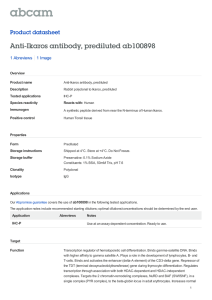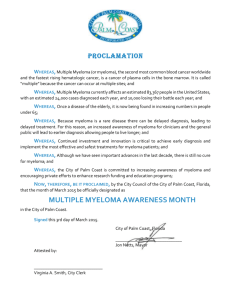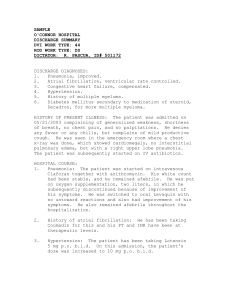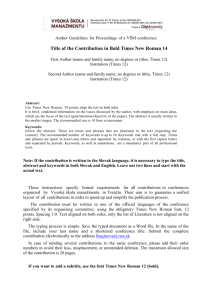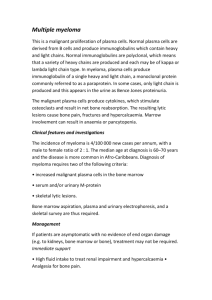Dr Pasquale Fedele RCPA Foundation Postgraduate Research Fellowship Final Report 2015
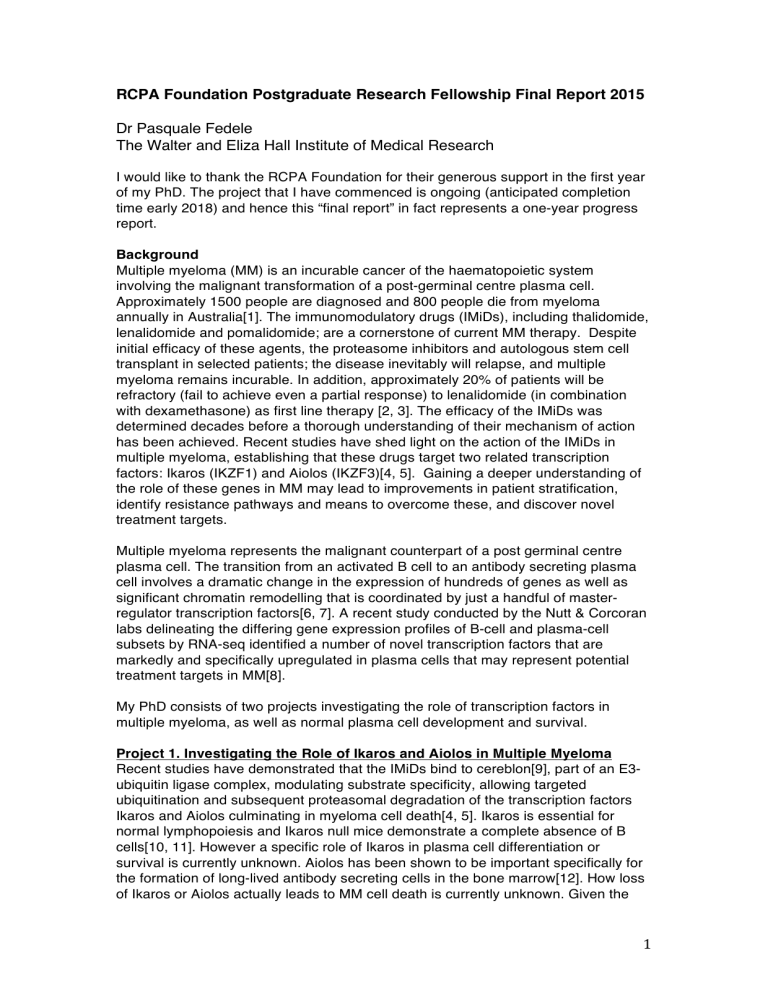
RCPA Foundation Postgraduate Research Fellowship Final Report 2015
Dr Pasquale Fedele
The Walter and Eliza Hall Institute of Medical Research
I would like to thank the RCPA Foundation for their generous support in the first year of my PhD. The project that I have commenced is ongoing (anticipated completion time early 2018) and hence this “final report” in fact represents a one-year progress report.
Background
Multiple myeloma (MM) is an incurable cancer of the haematopoietic system involving the malignant transformation of a post-germinal centre plasma cell.
Approximately 1500 people are diagnosed and 800 people die from myeloma annually in Australia[1]. The immunomodulatory drugs (IMiDs), including thalidomide, lenalidomide and pomalidomide; are a cornerstone of current MM therapy. Despite initial efficacy of these agents, the proteasome inhibitors and autologous stem cell transplant in selected patients; the disease inevitably will relapse, and multiple myeloma remains incurable. In addition, approximately 20% of patients will be refractory (fail to achieve even a partial response) to lenalidomide (in combination with dexamethasone) as first line therapy [2, 3]. The efficacy of the IMiDs was determined decades before a thorough understanding of their mechanism of action has been achieved. Recent studies have shed light on the action of the IMiDs in multiple myeloma, establishing that these drugs target two related transcription factors: Ikaros (IKZF1) and Aiolos (IKZF3)[4, 5]. Gaining a deeper understanding of the role of these genes in MM may lead to improvements in patient stratification, identify resistance pathways and means to overcome these, and discover novel treatment targets.
Multiple myeloma represents the malignant counterpart of a post germinal centre plasma cell. The transition from an activated B cell to an antibody secreting plasma cell involves a dramatic change in the expression of hundreds of genes as well as significant chromatin remodelling that is coordinated by just a handful of masterregulator transcription factors[6, 7]. A recent study conducted by the Nutt & Corcoran labs delineating the differing gene expression profiles of B-cell and plasma-cell subsets by RNA-seq identified a number of novel transcription factors that are markedly and specifically upregulated in plasma cells that may represent potential treatment targets in MM[8].
My PhD consists of two projects investigating the role of transcription factors in multiple myeloma, as well as normal plasma cell development and survival.
Project 1. Investigating the Role of Ikaros and Aiolos in Multiple Myeloma
Recent studies have demonstrated that the IMiDs bind to cereblon[9], part of an E3ubiquitin ligase complex, modulating substrate specificity, allowing targeted ubiquitination and subsequent proteasomal degradation of the transcription factors
Ikaros and Aiolos culminating in myeloma cell death[4, 5]. Ikaros is essential for normal lymphopoiesis and Ikaros null mice demonstrate a complete absence of B cells[10, 11]. However a specific role of Ikaros in plasma cell differentiation or survival is currently unknown. Aiolos has been shown to be important specifically for the formation of long-lived antibody secreting cells in the bone marrow[12]. How loss of Ikaros or Aiolos actually leads to MM cell death is currently unknown. Given the
1
expertise, techniques and technology available to me at the Walter and Eliza Hall
Institute (WEHI) and specifically Stephen Nutt’s lab, I am ideally placed to further investigate the role of these proteins in the context of normal plasma cell development and MM.
Aims
1.
Determine the role of Ikaros in plasma cell differentiation and survival.
2.
Investigate the interaction between Ikaros and Aiolos in these processes.
3.
Validate/Explore the proposed mechanism of action of the IMiDs in multiple myeloma.
• Identify novel downstream treatment targets of Ikaros and Aiolos
• Such targets may serve as biomarkers predicting treatment response/failure
• Understand the mechanisms of IMiD resistance
Progress to date:
1) Establishing mouse models to allow investigation of Ikaros and Aiolos in normal plasma cells and multiple myeloma
• We are utilising the IKZF1 fl/fl mouse (loxp sites flanking exon 8) combined to either CreER
T2
to allow inducible deletion of Ikaros on administration of tamoxifen, or CD23-Cre leading to constitutive deletion in mature B-cells. In addition we have bred these to Aiolos
-/-
mice (germline deletion) to allow the investigation of the interaction between these two proteins.
• These have then been combined with the Vk*MYC model of myeloma to facilitate the further investigation of the role ikaros in this disease. This model relies on the sporadic AID induced activation of a MYC transgene, thus specifically transforming germinal centre B cells [13].
We initially observed significantly lower incidence of paraprotein development in these mice than previously described. We hypothesised that reduced pathogen exposure in our animal facility may have resulted in reduced germinal centre formation and in keeping with this have found that immunisation (with sheep red blood cells injected IP) hastens the onset of disease (Figure 1).
2) Developing systems to allow the investigation of Ikaros and Aiolos in human multiple myeloma cell lines.
• Using CRISPR Cas9 as a platform to inactivate genes of interest in human myeloma cell lines. The doxycycline inducible Fgh1t sgRNA vector (designed by the Herold laboratory at WEHI) is tagged with GFP, while the Cas9 expression vector is tagged with mCherry, allowing FACS sorting for double positive cells.
• I have designed sgRNAs targeting Ikaros and Aiolos, cloned these into the
Fgh1t vector, infected these and Cas9 into MM cells (currently using the
OPM2 cell line) and then sorted single-cell colonies by flow-cytometry.
• These are still being worked up, however as shown below, treatment with doxycycline leads to knockdown of Ikaros and subsequent MM cell death
(Figure 2).
Project 2. Investigating Novel Transcription Factors in Multiple Myeloma
A recent study conducted by the Nutt & Corcoran labs delineating the differing gene expression profiles of murine B-cell and plasma-cell subsets by RNA-seq identified a number of novel transcription factors that are specifically upregulated in plasma cells that may represent potential treatment targets in MM. An additional project I have commenced is to explore the action some of these putative plasma cell transcription
2
factors with the ultimate aim of identifying novel treatment targets in multiple myeloma.
Aims
• Explore the action of recently identified novel putative plasma cell transcription factors.
• Identify key regulatory genes in the proliferation and survival of human myeloma cell lines (HMCLs) to bring through for further investigation.
• Identify novel treatment targets for multiple myeloma.
Progress to date:
1) Establish a pipeline to allow investigation of patient multiple myeloma samples to validate the importance these transcription factors in normal and malignant human plasma cells.
• This is part of a broader Multiple Myeloma Biobank that I am establishing at
Monash Health with Haematology unit head A/Prof Stephen Opat and Senior
Haematologist and Myeloma Lead Dr George Grigoriadis. The aim of this
Biobank is to allow greater translational research capabilities and foster increased collaboration with other institutions such as the Walter and Eliza
Hall Institute of Medical Research and the VCCC.
• This project has been approved by both Monash and WEHI HRECs.
• I have set up a protocol for plasma cell isolation using a combination of Ficoll gradient separation and flow cytometry sorting (Figure 3).
• Samples have been appropriately stored for RNA extraction and RNAseq will be conducted in near future. This will then allow comparison of “normal” patients’ plasma cells versus multiple myeloma cells with a specific focus on our previously identified plasma cell transcriptome “signature”.
2) CRISPR Cas9 as a platform to rapidly inactivate genes of interest in human myeloma cell lines.
• Currently working up gRNAs (2 per gene) for initial genes of interest.
Significance and relevance of these projects.
Both projects will expand our understanding of the genetic network underpinning the survival of normal and malignant plasma cells; potentially translating into improvements in MM patient care. Specifically:
• Increasing our understanding of the action of the IMiDs and role of Ikaros will facilitate the rational choice of drug combinations to enhance activity/overcome resistance.
• Identification of novel biomarkers predicting IMiD response will improve clinical decision making.
• Exploring genes regulated by Ikaros may identify novel treatment targets and/or mechanisms to overcome treatment refractoriness.
• Exploration of the role of previously undescribed plasma cell transcription factors may allow the identification of novel MM specific treatment targets.
3
Figures
Figure 1. Optimisation of the Vk*MYC Model of Multiple Myeloma
!!!
100!!!98!!!!!96!!!!93!!!!72!!!!71!!!!69!!!!!68!!!!64!!!!62!!!!!!!!!!!!!!!!!59!!!!56!!!!55!!!!45!!!!!44!!!!43!!!!37!!!!35!!!!!36!!!!39!!!!!!!!!!!!!!!!!!!!!!!!!!!!!!!!
!!
120%#
100%#
80%#
60%#
40%#
20%#
0%#
D2#
D3#
!!!Vk*MYC!#72!Spleen!!!!!!!!!!!!!!!!!!!!!!!!!!!!!!!!!!!!Vk*MYC!#72!Bone!Marrow
!!!!!!!!!!!!!!!!!!!!!!!!!
!!
Top: Serum protein electrophoresis of Vk*MYC mice 8-10 weeks following second immunisation with sheep red blood cells demonstrates presence of a paraprotein.
#39 Vk*MYC is unimmunised control. Bottom: Flow cytometry assessment of spleen and bone marrow of Vk*MYC #72 reveals marked bone marrow plasmacytosis consistent with previous reports.
Figure 2. CRISPR-Cas9 Mediated Ikaros Deletion Leads to MM Cell Death.
120%#
Ikaros#
#
#
Ac9n#
#
#
100%#
80%#
60%#
40%#
20%#
EV#%#Dox/No#Dox#
IKZF1#20C#276#%#Dox/No#Dox#
0%#
D2# D3# D4# D5# D6#
Left: Ikaros Western blot comparing empty vector (EV) with different colonies of the two IKZF1 sgRNAs (in OPM2 cells). Right: Flow cytometry assessment of viability of
D8#
EV#%#Dox/No#Dox#
IKZF1#20C#276#%#Dox/No#Dox#
D4# D5# D6# D8#
4
gRNA IKZF1 20C 2-6 vs EV following sgRNA induction with doxycycline (1 μ g/mL).
Graph depicts ratio of treated to untreated at timepoints shown.
Figure 3. Establishing a Protocol for Plasma Cell Isolation from Patient Bone
Marrow Samples.
CD138&–&PECy7&
Part of gating strategy for plasma cell sorting by flow cytometry.
Future Directions:
1.
Investigate the downstream gene regulatory program controlled by Ikaros in MM. a) Perform RNAseq on Ikaros deleted vs wild type human multiple myeloma cell lines. b) Perform ChIPseq to assess for Ikaros binding sites relevant to these differentially expressed genes.
2.
Investigate the key protein interactions influencing the role of Ikaros in both repression and activation of transcription
• Ikaros has previously been shown to variably interact in different cell types/developmental stages with chromatin/histone/transcription modifying complexes such as NuRD, PTEFb, PRC2 and SWI/SNF, as well as other transcription factors (including other members of the Ikaros family). a) Perform Co-IP (+/- mass spectrometry later) to determine key Ikaros protein interactions in multiple myeloma. b) Utilise CRISPR-Cas9 platform to both independently and concurrently delete key components of chromatin-remodelling complexes such as CHD4 (NuRD),
CDK9 (PTEFb), PP1a (PTEFb) and EZH2 (PRC2) that have previously been demonstrated to (variably) interact with Ikaros in different cell types. c) Analyse ChIPseq data specifically for Ikaros co-binding with these complexes and associated histone modifications; and then correlate this with associated transcriptional changes following Ikaros deletion.
5
3.
Determine the role/importance of Ikaros in normal plasma cell development and survival as well as the interaction with Ikaros. a) Using IKZF1 fl/fl
CD23-Cre/Cre-ERT2 +/- combined with Aiolos
-/-
mice. b) Determine phenotype using in-vitro and in-vivo systems well established in the Nutt laboratory. c) Perform RNAseq to investigate Ikaros/Aiolos activated and repressed genes in normal plasma cell development (and compare with those identified in the context of myeloma).
4.
Investigate the role of Ikaros in an in-vivo model of multiple myeloma (Vk*MYC). a) Transplant Vk*MYC IKZF1 fl/fl
“MM” cells (whole BM) or control into cohort of sub-lethally irradiated mice to enable further assessment in age/disease matched populations.
5.
Perform RNAseq on patient multiple myeloma and normal plasma cell samples to compare with the murine plasma cell transcriptional signature previously identified by the Nutt laboratory, as well as validate the expression of novel putative transcription factors.
6.
Further work-up of the role of novel putative transcription factors in the context of
MM using the CRISPR-Cas9 platform.
References
1.
2.
3.
4.
5.
Registries, A.I.o.H.a.W.A.A.o.C., 2012. Cancer in Australia-‐ an overview,
2012.
Cancer series no. 74, 2012. Cat. no. CAN 70. Canberra: AIHW.
Zonder, J.A., et al., Lenalidomide and high-‐dose dexamethasone compared with dexamethasone as initial therapy for multiple myeloma: a randomized
Southwest Oncology Group trial (S0232).
Blood, 2010. 116 (26): p. 5838-‐
41.
Rajkumar, S.V., et al., Lenalidomide plus high-‐dose dexamethasone versus lenalidomide plus low-‐dose dexamethasone as initial therapy for newly diagnosed multiple myeloma-‐ an open-‐label randomised controlled trial.
The Lancet Oncology, 2010. 11 : p. 29-‐37.
Lu, G., et al., The myeloma drug lenalidomide promotes the cereblon-‐ dependent destruction of Ikaros proteins.
Science, 2014. 343 (6168): p.
305-‐9.
Kronke, J., et al., Lenalidomide causes selective degradation of IKZF1 and
IKZF3 in multiple myeloma cells.
Science, 2014. 343 (6168): p. 301-‐5.
6.
7.
8.
Nutt, S.L., et al., The genetic network controlling plasma cell differentiation.
Semin Immunol, 2011. 23 (5): p. 341-‐9.
Nutt, S.L., et al., The generation of antibody-‐secreting plasma cells.
Nat Rev
Immunol, 2015. 15 (3): p. 160-‐71.
Shi, W., et al., Transcriptional profiling of mouse B cell terminal differentiation defines a signature for antibody-‐secreting plasma cells.
Nat
Immunol, 2015.
Ito, T., et al., Identification of a primary target of thalidomide 9. teratogenicity.
Science, 2010. 327 (5971): p. 1345-‐50.
10. Georgopoulos, K., et al., The ikaros gene is required for the development of all lymphoid lineages.
Cell, 1994. 79 (1): p. 143-‐156.
6
11. Wang, J.-‐H., et al., Selective Defects in the Development of the Fetal and
Adult Lymphoid System in Mice with an Ikaros Null Mutation.
Immunity,
1996. 5 (6): p. 537-‐549.
12. Cortes, M. and K. Georgopoulos, Aiolos is required for the generation of high affinity bone marrow plasma cells responsible for long-‐term immunity.
J Exp Med, 2004. 199 (2): p. 209-‐19.
13. Chesi, M., et al., AID-‐dependent activation of a MYC transgene induces multiple myeloma in a conditional mouse model of post-‐germinal center malignancies.
Cancer Cell, 2008. 13 (2): p. 167-‐80.
7

